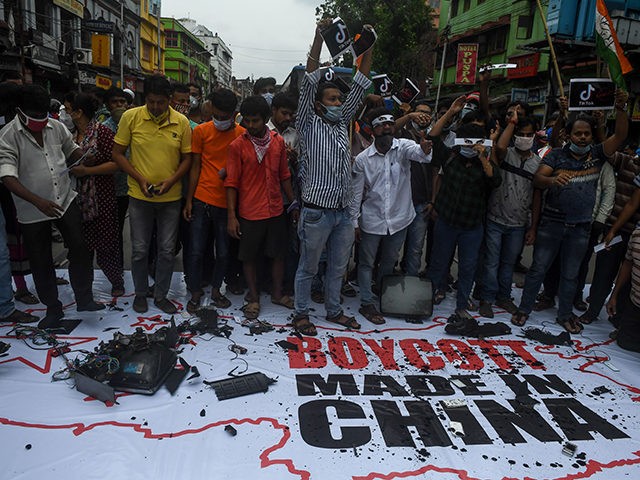Photos circulating on social media this week caused confusion, India’s News 18 reported on Wednesday, as Indian protesters waved a banner reading “boycott China” that depicted a map of the United States.
The images went viral after another incident in which anti-China protesters explained that they were burning China’s leader, “Kim Jong-un,” in effigy.
"Some people in Kolkata carried out yet another #BoycottChina protest. Except they used the map of USA instead of China," a Twitter user wrote. https://t.co/yYKgrrYDyr
— News18.com (@news18dotcom) June 24, 2020
Beijing has triggered a nationwide uproar in India following an hours-long brawl on the countries’ mutual border last week in which 20 Indian soldiers and an unknown number of Chinese soldiers were killed. The Chinese Communist Party refuses to reveal official casualty counts, but Indian officials have claimed that at least twice the number of People’s Liberation Army (PLA) soldiers died as the Indian troops.
In response, Indian civilians and merchant groups are calling for a nationwide boycott of Chinese imports and launched campaigns such as “Chinese products in dustbin,” an online challenge in which Indian people film themselves throwing Chinese made items in the trash. “Boycott China” movements are facing some difficulty, however, due to the sheer monopoly of Indian markets that China currently enjoys, resulting in few, if any, options to replace many Chinese items with alternatives from other countries.
In a protest against Chinese products in Kolkata, outraged locals burned an effigy of Chinese dictator Xi Jinping, now a common act at “boycott China” protests, and waved homemade signs and banners calling for the rejection of Chinese products. One of those showed a map of the United States overlayed with the flag of China. Also on the banner were images of Xi and Chinese brand logos like that of Oppo, a Chinese telecommunications corporation. According to News 18, the protest occurred on Friday.
The mistake recalled another incident in West Bengal this week at another ritual burning of Xi Jinping. Videos show the effigy wearing a printed-out portrait of Xi but, interviewed by local news, a member of the ruling Hindu nationalist Bharatiya Janata Party (BJP) participating in the protest identifies the leader of China “Pradhan Mantri [Prime Minister] Kim Jong-un.”
The triggering event for India’s outpouring of acrimony towards China was an attack – allegedly by the Chinese, Indian officials insisted – against India’s military in the Ladakh border region between the two countries. Indian reports alleged that China’s PLA erected a tent within Indian territory in the Galwan Valley, deep in the frigid Himalayas. When Indian soldiers confronted the Chinese about their violation of the nation’s sovereignty, the Chinese attacked them with rocks, clubs, and sticks wrapped in barbed wire. Reports in the aftermath of the incident indicated that the soldiers fought hand-to-hand and that many died by falling or being thrown off the steep Himalayan cliffs. Others died of hypothermia.
Chinese officials insist that the PLA had stayed squarely within Chinese territory and claimed the entire Galwan Valley for Beijing, a claim New Delhi vocally opposed.
“None of the responsibility lies with China,” Chinese Foreign Ministry spokesman Zhao Lijian said on Wednesday.
Zhao Lijian is the Foreign Ministry employee responsible for the conspiracy theory that the Chinese coronavirus pandemic began at a U.S. military facility in Maryland, a claim for which no evidence exists.
Indian politicians and citizens have not accepted China’s argument, polling and widespread protests show. In addition to the effigy burnings and other abuse (such as beheading the effigies and beating them into pieces), Indian groups have organized Chinese flag burnings and social media campaigns against China.
The Confederation of All India Traders (CAIT), an advocacy group for Indian merchants, has organized a formal call for a boycott of business with the Chinese Communist Party. On Wednesday, CAIT published a letter it sent to 50 prominent businessmen urging them to use their power to redirect Indian profits away from China.
“At a time when China’s army in the most clandestine manner has committed a barbaric attack on the Indian army at Ladakh border resulting into the brutal killing of 20 brave sons of the country, the heart of every Indian is filled with deep anguish, resentment, and abhorrence against the atrocities of the Chinese and their persistent attitude of antagonism towards India,” the CAIT letter read.
CAIT has announced a plan for a “phased” boycott of China which will began with no longer purchase finished products from China. Once that is complete, the organization will seek to start boycotting parts along industrial supply chains that come from China but end up in products made in India.
Attitudes towards China appear to have soured so rapidly that at least one poll shows Indians considering China a more imminent threat to the country than its longtime nuclear rival Pakistan. A poll published Wednesday by the India-Asia News Service (IANS), a newswire company, and the Indian polling agency CVoter found that nearly 70 percent of Indians see China as a “bigger problem for India” than Pakistan.
– –
Do you think #China is a bigger problem for #India than #Pakistan? Or do you think that Pakistan is a bigger problem for India than China?#IndiaChinaFaceOff #indiachinastandoff #GalwanValleyFaceOff pic.twitter.com/g5ZiVd0W7R
— IANS Tweets (@ians_india) June 23, 2020
The Communist Party has used its propaganda outlets to warn Indians that a boycott of China would be “extremely dangerous” for its economy and that the PLA can “smash” the Indian military, without offering clarity with an official casualty count from the Galwan Valley incident.
Follow Frances Martel on Facebook and Twitter.

COMMENTS
Please let us know if you're having issues with commenting.